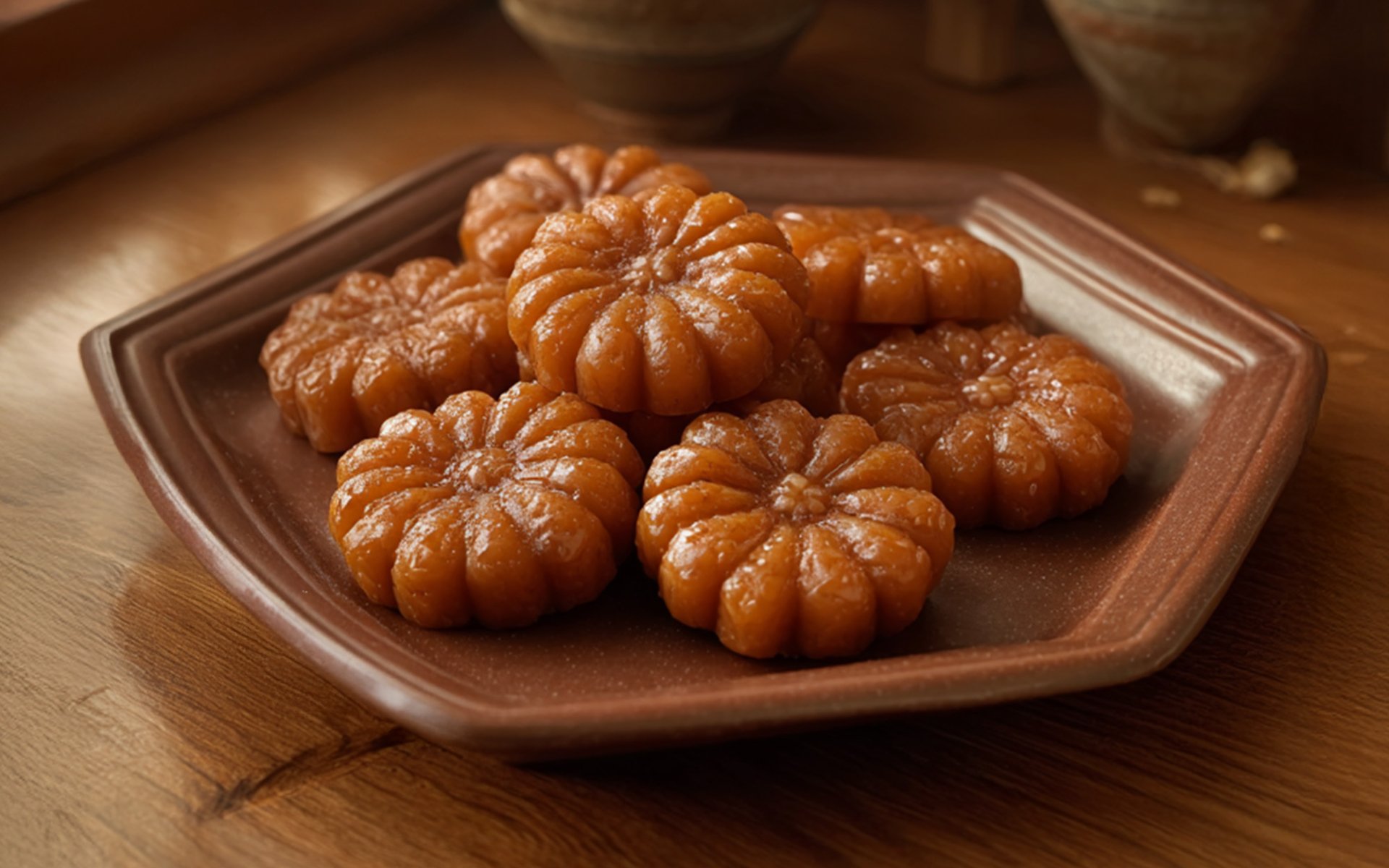Yakgwa (약과)
Last updated: 23 Sept 2025

Yakgwa (약과), also known as Yakgwa cookies, is a traditional Korean sweet that resembles cookies. This delicacy is made from wheat flour dough that is deep-fried and then soaked in a syrup made of honey, sesame oil, and ginger water, giving it a sweet aroma and a pleasantly chewy texture.
The word Yakgwa comes from Sino-Korean roots: Yak (藥) meaning medicine and Gwa (菓) meaning sweet or confection. Together, it literally translates to medicinal confection, reflecting the traditional belief that honeythe main ingredient of Yakgwahad medicinal properties to nourish and strengthen the body. For Koreans of the past, Yakgwa was not just a sweet treat but also a food with symbolic and nutritional value.
The history of Yakgwa can be traced back to Koreas Three Kingdoms period (57 BCE 668 CE), during which the peninsula was divided into the kingdoms of Goguryeo, Baekje, and Silla.
During this time, Buddhism spread widely into Korea, significantly influencing food culture. Since Buddhist teachings prohibited the consumption of meat, alternatives were needed for rituals and ancestral offerings. Yakgwa was created as a plant-based confection suitable for use in sacred ceremonies.
The process of making Yakgwa in its early days was highly complex, requiring precise control over frying temperatures and the balance of honey syrup.
Yakgwa became not only a ritual food but also a part of social ceremonies such as weddings, celebrations, and banquets. Its popularity grew so immense that some kings even issued laws to regulate consumption, highlighting just how widespread and significant it was in society.
However, in recent decades, Yakgwa has experienced a revival, boosted by the global fascination with Korean culture and cuisine. Today, Yakgwa is once again enjoyed both domestically and internationally, admired as part of Koreas culinary heritage.
In modern times, Yakgwa is often given as a gift during major holidays, such as Korean New Year (Seollal) and Chuseok (Harvest Moon Festival). It symbolizes good wishes, prosperity, and happiness for the coming year.
For those interested in trying Yakgwa at home, here are some recipes:
You can also find all the ingredients you need at Rimping Supermarket.
The word Yakgwa comes from Sino-Korean roots: Yak (藥) meaning medicine and Gwa (菓) meaning sweet or confection. Together, it literally translates to medicinal confection, reflecting the traditional belief that honeythe main ingredient of Yakgwahad medicinal properties to nourish and strengthen the body. For Koreans of the past, Yakgwa was not just a sweet treat but also a food with symbolic and nutritional value.
Origins and Early History
The history of Yakgwa can be traced back to Koreas Three Kingdoms period (57 BCE 668 CE), during which the peninsula was divided into the kingdoms of Goguryeo, Baekje, and Silla.
During this time, Buddhism spread widely into Korea, significantly influencing food culture. Since Buddhist teachings prohibited the consumption of meat, alternatives were needed for rituals and ancestral offerings. Yakgwa was created as a plant-based confection suitable for use in sacred ceremonies.
The process of making Yakgwa in its early days was highly complex, requiring precise control over frying temperatures and the balance of honey syrup.
Symbolism in Ingredients and Design
Traditional Yakgwa is made with rice flour, honey, sesame oil, ginger, cinnamon, and a touch of black pepper. Each ingredient holds its own symbolic meaning:
- Honey: Sweetness, believed to relieve coughs and sore throats.
- Sesame oil: Aroma and richness, thought to strengthen bones and joints.
- Ginger: Aids digestion and considered medicinal.
- Cinnamon & black pepper: Add subtle spice, balancing sweetness.
Rise During the Goryeo Dynasty
In the Goryeo Dynasty (9181392), Buddhism was established as Koreas state religion, further popularizing Yakgwa across all social classesfrom royalty and temples to common households.Yakgwa became not only a ritual food but also a part of social ceremonies such as weddings, celebrations, and banquets. Its popularity grew so immense that some kings even issued laws to regulate consumption, highlighting just how widespread and significant it was in society.
Cultural Exchange with China
During the same era, recipes and techniques for making Yakgwa spread beyond Korea to China, carried through trade and cultural exchanges. Merchants traveling between the two nations shared culinary practices, making Yakgwa known outside of Korea.Decline and Revival
Despite its long-standing tradition, Yakgwas popularity began to wane in the 20th century due to the rise of modern, Western-style sweets. Its complicated and time-consuming preparation also contributed to younger generations favoring quicker, more convenient options.However, in recent decades, Yakgwa has experienced a revival, boosted by the global fascination with Korean culture and cuisine. Today, Yakgwa is once again enjoyed both domestically and internationally, admired as part of Koreas culinary heritage.
In modern times, Yakgwa is often given as a gift during major holidays, such as Korean New Year (Seollal) and Chuseok (Harvest Moon Festival). It symbolizes good wishes, prosperity, and happiness for the coming year.
For those interested in trying Yakgwa at home, here are some recipes:
You can also find all the ingredients you need at Rimping Supermarket.
Tags :
Related Content
Getting to Know Potato Dumplings A Dish Highly Popular Across Central and Eastern Europe


